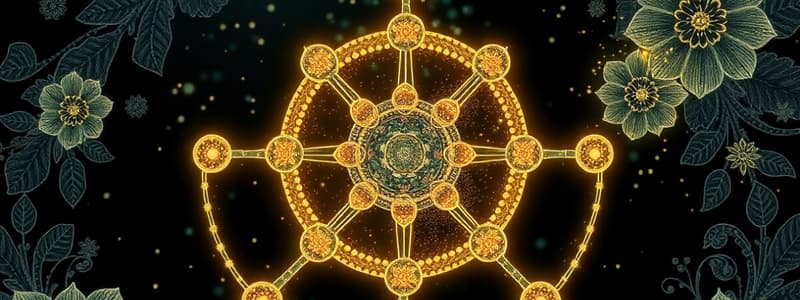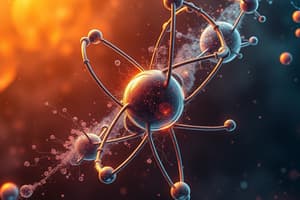Podcast
Questions and Answers
What are the positively charged particles found in the nucleus of an atom called?
What are the positively charged particles found in the nucleus of an atom called?
- Protons (correct)
- Electrons
- Nucleons
- Neutrons
Which part of the atom is responsible for its atomic mass?
Which part of the atom is responsible for its atomic mass?
- The number of protons and neutrons (correct)
- The orbital shapes
- The energy levels of the electrons
- The number of electrons
What is the primary characteristic of the electron cloud?
What is the primary characteristic of the electron cloud?
- It has fixed paths (orbits) for the electrons.
- It contains only negatively charged particles.
- It only contains protons and neutrons.
- It represents a probabilistic region for electron locations. (correct)
How do electrons fill energy levels in an atom?
How do electrons fill energy levels in an atom?
What type of subatomic particles are found in the nucleus of an atom, along with protons?
What type of subatomic particles are found in the nucleus of an atom, along with protons?
What role do protons play in an atom?
What role do protons play in an atom?
How do isotopes of an element differ from one another?
How do isotopes of an element differ from one another?
What is the relationship between atomic number and the periodic table?
What is the relationship between atomic number and the periodic table?
Which atomic model proposed that atoms consist of a positively charged sphere with electrons embedded in it?
Which atomic model proposed that atoms consist of a positively charged sphere with electrons embedded in it?
What is the mass number of an atom with 3 protons and 4 neutrons?
What is the mass number of an atom with 3 protons and 4 neutrons?
Which type of bond is formed through the sharing of electrons?
Which type of bond is formed through the sharing of electrons?
In which block of the periodic table would you find transition metals?
In which block of the periodic table would you find transition metals?
Which atomic model introduced quantized electron orbits around the nucleus?
Which atomic model introduced quantized electron orbits around the nucleus?
What is the charge of a neutron?
What is the charge of a neutron?
Which of the following correctly describes the relationship between protons and the atomic number?
Which of the following correctly describes the relationship between protons and the atomic number?
Which statement about electrons is accurate?
Which statement about electrons is accurate?
What does the mass number of an atom represent?
What does the mass number of an atom represent?
How do isotopes differ from each other?
How do isotopes differ from each other?
What happens to an atom that gains an electron?
What happens to an atom that gains an electron?
Which particle primarily determines the chemical properties of an atom?
Which particle primarily determines the chemical properties of an atom?
Flashcards are hidden until you start studying
Study Notes
Atomic Structure
- The atom is the smallest unit of matter that retains the properties of an element
- The atom is comprised of protons and neutrons in a central nucleus, surrounded by electrons in an electron cloud
Nucleus
- The nucleus is the dense central part of the atom, containing most of its mass
- Protons carry a positive charge (+1) and are located in the nucleus
- Neutrons are neutral particles (no charge) housed in the nucleus and contribute to the atomic mass.
Electrons
- Electrons are negatively charged particles (-1) that orbit the nucleus
- They are arranged in energy levels or shells around the nucleus, with each level having a specific capacity for electrons
- Electrons fill the lowest available energy levels first, before moving to higher levels
Atomic Number and Mass Number
- The Atomic Number is the number of protons in the nucleus of an atom
- The Atomic Number determines the element's identity and position on the Periodic Table
- The Mass Number is the sum of protons and neutrons in the nucleus, it provides an estimation of the atom's mass
Isotopes
- Isotopes are atoms of the same element that have the same number of protons, but different numbers of neutrons
- They share the same chemical properties, but differ in physical properties, such as mass and stability
The Periodic Table and Atomic Structure
- The Periodic Table is organized based on elements' atomic structure and properties
- Elements in the same group have similar chemical properties, due to similar electron configurations
- Elements in the same period have the same number of electron shells
Atomic Models
- Dalton’s Model proposed that atoms are indivisible particles and combine in fixed ratios to form compounds
- Thomson’s Model proposed that atoms consist of a positively charged sphere with embedded negatively charged electrons
- Rutherford’s Model introduced the concept of a dense, positively charged nucleus surrounded by orbiting electrons
- Bohr’s Model refined Rutherford's model by introducing quantized electron orbits
- Quantum Mechanical Model describes electrons as existing in probabilistic regions around the nucleus called orbitals
Atomic Interactions and Bonding
- Atoms interact with each other through chemical bonds to form molecules and compounds
- Ionic Bonds form between atoms with significantly different electronegativities, one atom donates electrons to another, creating positively and negatively charged ions that attract
- Covalent Bonds form when atoms share electrons to achieve a stable electron configuration.
- Metallic Bonds occur between metal atoms, where electrons are shared collectively in a "sea" of electrons
Biological Significance of Protons, Neutrons, and Electrons
- Protons are central to the formation of hydrogen bonds which are crucial for the structure and function of molecules such as DNA and proteins
- Isotopes are used in biological research and medicine, with Carbon-14 used in radiocarbon dating, and radioactive tracers used to image parts of the body in PET scans
- Ions play a key role in physiological functions, with sodium and potassium ions crucial for nerve impulse transmission and calcium ions crucial for muscle contraction, neurotransmitter release, and blood clotting.
Studying That Suits You
Use AI to generate personalized quizzes and flashcards to suit your learning preferences.




